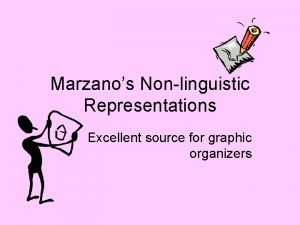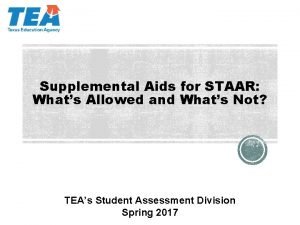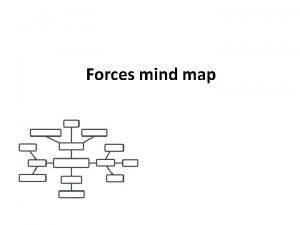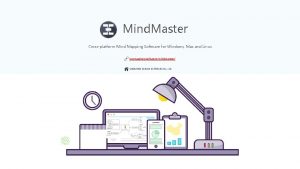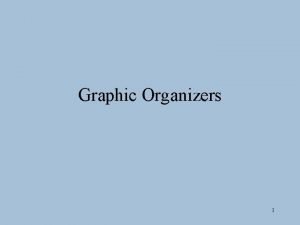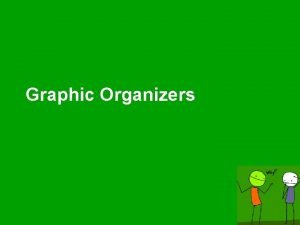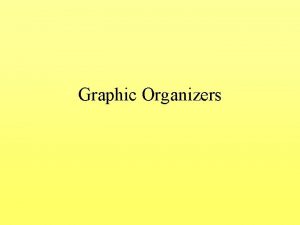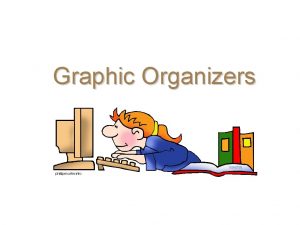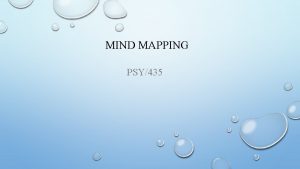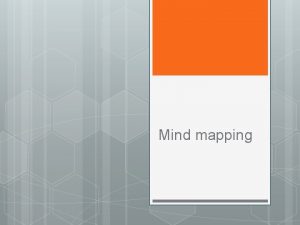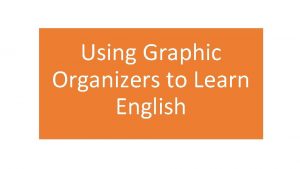Graphic Organizers Mind Mapping a mind map is













- Slides: 13

Graphic Organizers

Mind Mapping • a mind map is a diagram used to visually outline information • can be used to generate, visualize, structure, and classify ideas, and as an aid to studying and organizing information, solving problems, making decisions, and writing • has many applications such as notetaking, brainstorming, summarizing, or to sort out a complicated idea. • created around a single word or text, placed in the center, to which associated ideas, words and concepts are added. • major categories radiate from a central word, and lesser categories are sub-branches of larger branches. • categories can represent words, ideas, tasks, or other items related to a central key word or idea. • can be drawn by hand, either as "rough notes" during a lecture or meeting, for example, or as higher quality pictures when more time is available Footer Text 11/27/2020 2

Guidelines 1. 2. 3. 4. 5. 6. 7. 8. 9. Start in the center with an image of the topic. Use images, symbols, and notes throughout your mind map. Select key words and print using upper or lower case letters. Each word/image is best alone and sitting on its own line. The lines should be connected, starting from the central image. The central lines are thicker, organic and thinner as they radiate out from the center. Use multiple colors (optional) throughout the mind map, for visual stimulation and also to encode or group. Develop your own personal style of mind mapping. Use emphasis and show associations in your mind map. Keep the mind map clear by using radial hierarchy, numerical order or outlines to embrace your branches. Footer Text 11/27/2020 3

Footer Text 11/27/2020 4

Concept Mapping • a diagram that depicts suggested relationships between concepts…. ie visualizing relationships among different concepts • a graphical tool that designers, engineers, technical writers, and others use to organize and structure knowledge. • typically represents ideas and information as boxes or circles, which it connects with labeled arrows in a downward-branching hierarchical structure. • linking lines can include phrases such as “causes”, “requires”, or “contributes to” Footer Text 11/27/2020 5

Guidelines 1. Identify the general/broad topic that you are interested in. 2. Brainstorm on the general topic and list all the concepts and themes 3. write the main theme in the center of the page…. OR… set up “parking lot” using post it notes and arrange the concepts 4. Take the other concepts identified in the brainstorming and connect them to the center concept. 5. You can use other organizational patterns such as branches, arrows or groups. More important ideas should be put nearer to the center and less important ones closer to the edge. Identify the relationship between the concepts. 6. look at the organizational patterns to see if the pieces fit together and make sense and if there is anything missing. Refine the Concept Map 7. Look for new relations and further refine 8. Finalize the Concept Map Footer Text 11/27/2020 6

Footer Text 11/27/2020 7

MIND MAPPING CONCEPT MAPPING commonly used to visually outline information tends to be more flexible and personal than concept maps fix on a single conceptual center…one word or idea techniques for visualizing ideas, processes, organizations connect multiple words or ideas makes concepts the central elements in the structure commonly used to organize and represent knowledge can be a map, a system view, of a system or set of concepts often restricted to radial hierarchies (order) and tree structures are used to slice and dice the map’s central topic or concept in multiple ways reflects what you think about a single topic usually contain general concepts at the top of the map, with more specific concepts arranged hierarchically (orderly) below. typically have text labels on their connecting lines/arms based on connections between concepts in more diverse patterns spontaneity and speed is key may contain images and color, to make them more visually stimulating more free form, as multiple hubs and clusters can be created, topics in mind maps may only have one parent; in a concept map topics may be cross-linked with each other to depict relationships between topics a topic may have multiple connector lines, each one representing a different 11/27/2020 8 relationship. Footer Text

Fishbone Chart • Fishbone diagrams, or cause-and-effect diagrams, are causal diagrams that show the causes of a specific event. Common uses are for product design and quality defect prevention, to identify potential factors causing an overall effect. Each cause or reason for imperfection is a source of variation. Causes are usually grouped into major categories to identify these sources of variation. Footer Text 11/27/2020 9

Fishbone Categories • People: anyone involved with the process • Methods: how the process is performed and the specific requirements for doing it, such as policies, procedures, rules, regulations and laws • Machines: any equipment, computers, tools, etc. required to accomplish the job • Materials: raw materials, parts, pens, paper, etc. used to produce the final product • Measurements: data generated from the process that are used to evaluate its quality • Environment: conditions, such as location, time, temperature, and culture in which the process operates Footer Text 11/27/2020 10

Footer Text 11/27/2020 11

Hierarchical Organization Chart • an organizational structure where every entity in the organization, except one, is subordinate to a single other entity. • the hierarchy usually consists of a singular/group of power at the top with subsequent levels of power beneath them. • dominant mode of organization among large organizations • Includes most corporations, governments, and organized religions • is typically visualized as a pyramid, tree or triangle diagram • height of the ranking and the width represents how many people or business divisions • highest-ranking people are at the apex, and there are very few of them • he base may include subordinates. • those nearest the top have more power than those nearest the bottom, • superiors in a hierarchy generally have higher status and command greater Footer Text rewards 11/27/2020 12

Footer Text 11/27/2020 13
 Tea supplemental aids
Tea supplemental aids Tea approved graphic organizers
Tea approved graphic organizers Supplemental aids
Supplemental aids Hierarchical graphic organizer example
Hierarchical graphic organizer example Mcas accommodations codes
Mcas accommodations codes Generalization pattern organizer
Generalization pattern organizer Blank graphic organizers for math staar
Blank graphic organizers for math staar Marzanos strategies
Marzanos strategies Mcas graphic organizer
Mcas graphic organizer Mind mapping graphic organizer
Mind mapping graphic organizer Mind map about friction
Mind map about friction Mindmap master
Mindmap master Memory parameters
Memory parameters Forward mapping vs backward mapping
Forward mapping vs backward mapping





